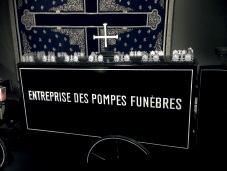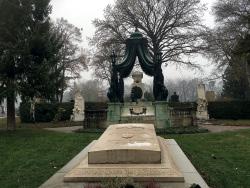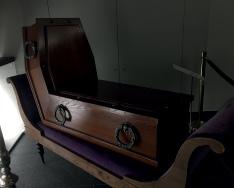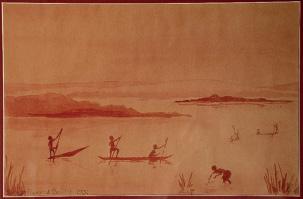
5 minute read
Oh Vienna
On a trip to explore Vienna’s glorious Christmas markets I discovered one of the largest cemeteries in Europe, Central Cemetery, completely by accident.
Having a few drinks with my friends we got chatting to a German tourist whose passion happened to be visiting cemeteries! What are the chances? – it had to be fate! His enthusiasm was infectious and by the end of the evening he had managed to persuade all my friends to add it to our itinerary. I, obviously, didn’t need any convincing that the MUST do activity on any holiday is to visit a cemetery!
Advertisement
So, whilst the iron was still hot – strike I did. We set off with a city map and bus tickets in the direction of the outskirts of the city towards a district called Simmering. When Vienna grew into a city of more than one million inhabitants, the old cemeteries of the various districts became too small. To accommodate the growing capital, the Central Cemetery, with an area of over 600 acres, was opened in 1874. The first individual funeral to take place was for Jakob Zelzer. The grave still stands today.
The Vienna Central Cemetery has over 330, 000 graves and 3 million deceased buried there. It is one of Europe’s largest cemeteries and is interdenominational. Alongside Catholic graves of the main interdenominational section, the extensive grounds also house a Protestant cemetery, the new and old Jewish cemetery, an
Family Mausolea in Jewish section Islamic section, a Syriac Orthodox section, a Muslim Egyptian section, a Coptic Orthodox section, a Greek Orthodox section, a Russian Orthodox section, a Romanian Orthodox section, a Serbian Orthodox section and burial plots for those who have donated their bodies to anatomical research. The size of the cemetery is overwhelming and truly impressive. There are several different entrances to the site and a little research should be carried out before visiting as well as a good pair of walking shoes!
In the first decades following its opening, Vienna Central Cemetery was not very popular in view of its distance from the city and wide open, barren spaces that prevailed at that time. However, with the construction of the honorary grave area, the cemetery soon turned into an attractive destination for visitors. Many famous and deserving people who had died before the cemetery was built and were interred in other cemeteries in Vienna were transferred here.
Honorary graves are an integral part of Vienna's cultural history. They represent a significant honour which can be bestowed by the City of Vienna on public figures after their death. Today, around 1,000 honorary graves can be found in the Wolfgang Amadeus Mozart honorary grave lot and in other lots designated as honorary graves.
The cemetery has been enlarged a total of seven times, most recently in 1921. Vienna Central Cemetery suffered considerable bomb damage from air raids conducted during the Second World War. 12,000 graves and hundreds of crypts were completely destroyed. Every building was damaged. The church's dome was obliterated by an incendiary bomb. Following extensive restoration work, Vienna Central Cemetery has since assumed the position of the most important burial site in Vienna and presents itself as a cemetery for every religion.
The people buried there come from all walks of public life in Vienna up until the very recent past. They achieved renown in the areas of music, poetry, science, architecture, painting, invention, acting, politics or sport. Politicians who played a key role in shaping the fortunes of Austria are also buried in honorary graves. The presidential crypt in front of the Art Nouveau church is the final resting place of every Austrian federal president since 1945.
Cemeteries are places of culture and part of Vienna’s history as a city. Apart from thousands of graves, there are also green spaces, trees, churches, historical buildings and cultural monuments to be seen.
If you visit the site, you won’t find big neon signs pointing to the most interesting graves and crypts, which is fair enough as it’s a working cemetery and not primarily a tourist attraction, facilitating 20 or 25 burials a day. For those lovers of classical music, or even just an appreciation of memorialisation, a visit to this cemetery—Section 32A—-Gate 2 is a moving experience as a tribute to the wonderful legacies of composers including Beethoven, Schubert, Johannes Strauss, Von Suppé, Schonberg and Mozart.
The cemetery administration department and two of the three morgues are situated next to the main entrance. The Hugo Wolf old, imposing covered footpaths with 36 crypts can be clearly seen from the gate. They were built in a Neo-Renaissance style. The cemetery church of St. Charles Borromeo sits prominently and is the most significant Art Nouveau church building, together with Otto Wagner's Church of St. Leopold at Steinhof, in Vienna. After approximately three years of construction work, the church was inaugurated in 1911. It underwent comprehensive renovation work between 1995 and 2000.
The Central Cemetery is also home to a Funeral Museum and gives insights into the funeral and cemetery culture of past centuries. You can expect to learn interesting facts about the Viennese funeral service, the funeral industry, the history of Vienna’s Church of St. Barromeo cemeteries and about the features of the "Viennese cult of the dead" from the end of the 18th century until today. More than 250 original objects and photographic material are on display, including an original "Fourgon" (coach for transporting bodies) from around the year 1900. A heart palpitation knife and a life-saving clock are the most bizarre exhibits: they date to a time when people worried about being buried alive. From the year 1784 comes the famous foldaway coffin, which Emperor Joseph II had used in order to be able to recycle coffins several times.
The cemetery is so big you can literally spend days there – which quite honestly, I would have happily done but unfortunately my friends didn’t share the same enthusiasm! To be fair it was cold, and we were only there for a long weekend, so reluctantly we headed back in search of a warm bar! There is so much I didn’t get to explore so will definitely be planning another visit. I would highly recommend you put this on your “to do” list!
Sofia Allana Editor












